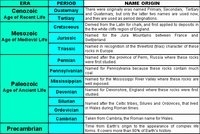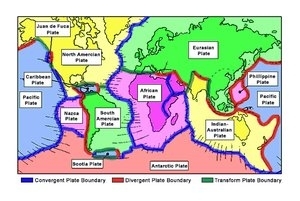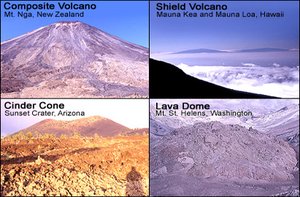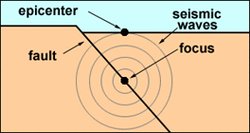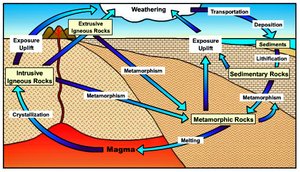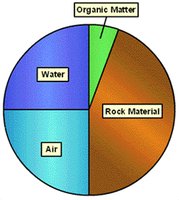AP Environmental Science Chapter 3- The Solid Earth
Contents
Chapter Objectives
Describe the thickness, composition, and condition of Earth's three major internal layers.
Outline the theory of plate tectonics (AP Environmental Science Chapter 3- The Solid Earth) , define the three types of plate boundaries, and list the landforms and geologic activities associated with each boundary type.
- Compare and contrast the appearance and behavior of cinder cones and shield and composite volcanoes.
- Diagram the rock cycle and describe how rocks are transformed from one type to another.
- Describe the composition and formation of soil.
Introduction
The speculations of early civilizations regarding the nature of the earth were mostly based on lore and legend rather than scientific thought. But a few individuals did manage some remarkable insight. The Greek historian Herodotus, who lived during the 5th century B.C., correctly deduced that the Mediterranean Sea had once extended much farther to the south based on the discovery of fossil shells in the interior parts of Egypt and Libya. During the 3rd century B.C., the Greek mathematician Eratosthenes concluded the Earth was spherical, calculated its diameter and circumference. Yet, few people believed or could even comprehend such assertions. Misconceptions and prejudices regarding the nature of the earth came and went through the centuries. Only a little more than 500 years ago, sailors aboard Columbus' ships begged him to turn back, because they were fearful that they would fall off the edge of the earth. Until recently, most people held the traditional belief that the earth's age could be measured on the order of thousands of years, not millions or billions.We now know that the earth is more than 4.5 billion years old, and that the surface of the earth has undergone continual change. Limestone that now comprises a mountain (AP Environmental Science Chapter 3- The Solid Earth) was once a coral reef in an ancient tropical sea hundreds of millions of years earlier. Granitic rock that now soars thousands of feet above sea level was originally formed deep in the earth's crust. Water and wind erode the rocky faces of mountains and carry away the bits of rock to accumulate as sediments in a lake or ocean. The sediments become buried and compacted and form new rocks, which in turn form new mountains and complete the natural cycle. Scientists use their knowledge of how rocks form and change and how old they are in order to develop a comprehensive understanding of the earth and its geologic history.
Video: The Solid Earth (High Bandwidth); (Low Bandwidth)
Earth's Formation and Structure
The earth formed approximately 4.6 billion years ago from a nebular cloud of dust and gas that surrounded the sun. As the gas cooled, more solids formed. The dusty material accreted to the nebular midplane where it formed progressively larger clumps. Eventually, bodies of several kilometers in diameter formed; these are known as planetesimals. The largest planetesimals grew fastest, at the expense of the smaller ones. This process continued until an earth-sized planet had formed.
Early in its formation, the earth must have been completely molten. The main source of heat at that time was probably the decay of naturally-occurring radioactive elements. As the earth cooled, density differences between the forming minerals caused the interior to become differentiated into three concentric zones: the crust, mantle and core. The crust extends downward from the surface to an average depth of 35 km where the mantle begins. The mantle extends down to a depth of 2900 km where the core begins. The core extends down to the center of the earth, a depth of about 6400 km from the surface.
The core makes up 16 percent of the volume of the earth and about 31 percent of the mass. It can be divided into two regions: a solid inner core and a liquid outer core. The inner core is probably mostly metallic iron alloyed with a small amount of nickel, as its density is somewhat greater than that of pure metallic iron. The outer core is similar in composition, but probably also contains small amounts of lighter elements, such as sulfur and oxygen, because its density is slightly less than that of pure metallic iron. The presence of the lighter elements depresses the freezing point and is probably responsible for the outer core's liquid state.
The mantle is the largest layer in the earth, making up about 82 percent of the volume and 68 percent of the mass of the earth. The mantle is dominated by Magnesium and iron-rich (mafic) minerals. Heat from the core of the earth is transported to the crustal region by large-scale convection in the mantle.
Near the top of the mantle is a region of partially melted rock called the asthenosphere. Numerous small-scale convection currents occur here as hot magma (i.e., molten rock) rises and cooler magma sinks due to differences in density.
The crust is the thinnest layer in the earth, making up only 1 percent of the mass and 2 percent of the volume. Relative to the rest of the earth, the crust is rich in elements such as silicon, aluminum, calcium, sodium and potassium. Crustal materials are very diverse, consisting of more than 2000 minerals. The less dense crust floats upon the mantle in two forms: the continental crust and the oceanic crust. The oceanic crust, which contains more mafic minerals is thinner and denser than the continental crust which contains minerals richer in silicon and aluminum. The thick continental crust has deep buoyant roots that help to support the higher elevations above. The crust contains the mineral resources and the fossil fuels used by humans.
Geologic Time Scale
The Earth is more than 4.5 billion years old and such a large interval of time can be difficult for the average person to comprehend. Although there is not a direct record of most of this past geologic time, earth scientists have indirect evidence of what took place in the past in the record of the earth's rocks. Some of these rock records are lost and others are jumbled, but many remain, providing accounts of the astonishing events that have taken place in the life of the earth. Geologists can reconstruct these events by combining studies on the origins of rocks (petrology) and rock layering (stratigraphy) with the evolution of life (paleontology). Using key fossils found in rock layers as markers, scientists can identify rocks of the same age throughout the world. From these studies, a relative geologic time scale based on the sequence of rock layering was established.
This geologic time scale consists of segments of time represented by recurring geologic events such as mountain building and sea level changes. Geologists have used these time segments to divide the earth's history into broad time spans known as Eons and Eras and shorter spans known as Periods and Epochs. Major discontinuities in the geologic and fossil records are chosen as boundary lines between the different time segments. For example, the boundary between the Cretaceous Tertiary periods marks a sudden mass extinction of species the included the dinosaurs. More recently, a radiometric time scale, based on the natural radioactivity of the chemical elements in rocks, has been developed through the use of modern quantitative experimental techniques. Using these techniques, absolute ages can be assigned to some parts of the geologic time scale. For example the Cretaceous-Tertiary boundary represents a time approximately 65 million years ago.
The Lithosphere and Plate Tectonics
The layer of the mantle above the asthenosphere plus the entire crust make up a region called the lithosphere. The lithosphere, and therefore, the earth's crust, is not a continuous shell, but is broken into a series of plates that independently "float" upon the asthenosphere, much like a raft on the ocean. These plates are in constant motion, typically moving a few centimeters a year, and are driven by convection in the mantle. The scientific theory that describes this phenomenon is called plate tectonics. According to the theory of plate tectonics, the lithosphere is comprised of some seven major plates and several smaller ones. Because these plates are in constant motion, interactions occur where plate boundaries meet.
A convergent (colliding) plate boundary occurs when two plates collide. If the convergent boundary involves two continental plates, the crust is compressed into high mountain ranges such as the Himalayas. If an oceanic plate and a continental plate collide, the oceanic crust (because it is more dense) is subducted under the continental crust.
The region where subduction takes place is called a subduction zone and usually results in a deep ocean trench such as the "Mariana Trench" in the western Pacific Ocean. The subducted crust melts and the resultant magma can rise to the surface and form a volcano. A divergent plate boundary occurs when two plates move away from each other. Magma upwelling from the mantle region is forced through the resulting cracks, forming new crust. The mid-ocean ridge in the Atlantic Ocean is a region where new crustal material continually forms as plates diverge. Volcanoes can also occur at divergent boundaries. The island of Iceland is an example of such an occurrence. A third type of plate boundary is the transform boundary. This occurs when two plates slide past one another. This interaction can build up strain in the adjacent crustal regions, resulting in earthquakes when the strain is released. The San Andreas Fault in California is an example of a transform plate boundary.
Animation: Convergent plates
Animation: Divergent plates
Animation: Transform plates
Geological Disturbances
Volcanoes
An active volcano occurs when magma (molten rock) reaches the earth's surface through a crack or vent in the crust. Volcanic activity can involve the extrusion of lava on the surface, the ejection of solid rock and ash, and the release of water vapor or gas (carbon dioxide or sulfur dioxide). Volcanoes commonly occur near plate boundaries where the motion of the plates has created cracks in the lithosphere through which the magma can flow. About eighty percent of volcanoes occur at convergent plate boundaries where subducted material melts and rises through cracks in the crust. The Cascade Range was formed in this way.
Volcanoes can be classified according to the type and form of their ejecta. The basic types are: composite volcanoes, shield volcanoes, lava domes, and cinder cones. Composite volcanoes are steep-sided, symmetrical cones built of multiple layers of viscous lava and ash.
Most composite volcanoes have a crater at the summit which contains the central vent. Lavas flow from breaks in the crater wall or from cracks on the flanks of the cone. Mt Fuji in Japan and Mt Ranier in Washington are examples of composite volcanoes.
Shield volcanoes are built almost entirely of highly fluid (low viscosity) lava flows. They form slowly from numerous flows that spread out over a wide area from a central vent. The resultant structure is a broad, gently sloping cone with a profile like a warrior's shield. Mt Kilauea in Hawaii is an example of a shield volcano.
Cinder cones are the simplest type of volcano. They form when lava blown violently into the area breaks into small fragments that solidify and fall as cinders. A steep-sided cone shape is formed around the vent, with a crater at the summit. Sunset Crater in Arizona is a cinder cone that formed less than a thousand years ago, disrupting the lives of the native inhabitants of the region.
Lava domes are formed when highly viscous lava is extruded from a vent and forms a rounded, steep-sided dome. The lava piles up around and on the vent instead of flowing away, mostly growing by expansion from within. Lava domes commonly occur within the craters or on the flanks of composite volcanoes.
Animation: Composite volcanoes
Animation: Cinder cones
Animation: Shield volcanoes
Video: Volcanoes (High Bandwidth); (Low Bandwidth)
Earthquakes
An earthquake occurs when built up strain in a rock mass causes it to rupture suddenly. The region where the rupture occurs is called the focus. This is often deep below the surface of the crust. The point on the surface directly above the focus is called the epicenter. Destructive waves propagate outward from the region of the quake, traveling throughout the earth. The magnitude of an earthquake is a measure of the total amount of energy released.
The first step in determining the magnitude is to measure the propagated waves using a device called a seismograph. Based on this information, the earthquake is given a number classification on a modified Richter scale. The scale is logarithmic, so a difference of one unit means a difference of ten-fold in wave intensity, which corresponds to an energy difference of 32-fold. The intensity of an earthquake is an indicator of the effect of an earthquake at a particular locale. The effect depends not only on the magnitude of the earthquake, but also the types of subsurface materials and the structure and design of surface structures.
Earthquakes generally occur along breaks in the rock mass known as faults, and most occur in regions near plate boundaries. Some 80 percent of all earthquakes occur near convergent plate boundaries, triggered by the interaction of the plates. Earthquakes are also often associated with volcanic activity due to the movement of sub-surface magma. When an earthquake occurs under the ocean, it can trigger a destructive tidal wave known as a tsunami.
Rocks and the Rock Cycle
The earth's crust is composed of many kinds of rocks, each of which is made up of one or more minerals. Rocks can be classified into three basic groups: igneous, sedimentary, and metamorphic. Igneous rocks are the most common rock type found in the earth's crust. They form when magma cools and crystallizes subsurface (intrusive igneous rocks) or lava cools and crystallizes on the surface (extrusive igneous rocks). Granite is an example of an intrusive igneous rock, whereas basalt is an extrusive igneous rock.
Sedimentary rocks are formed by the consolidation of the weathered fragments of pre-existing rocks, by the precipitation of minerals from solution, or by compaction of the remains of living organisms. The processes involving weathered rock fragments include erosion and transport by wind, water or ice, followed by deposition as sediments. As the sediments accumulate over time, those at the bottom are compacted. They are cemented by minerals precipitated from solution and become rocks.
The process of compaction and cementation is known as lithification. Some common types of sedimentary rocks are limestone, shale, and sandstone. Gypsum represents a sedimentary rock precipitated from solution. Fossil fuels such as coal and oil shale are sedimentary rocks formed from organic matter.
Metamorphic rocks are formed when solid igneous, sedimentary or metamorphic rocks change in response to elevated temperature and pressure and/or chemically active fluids. This alteration usually occurs subsurface. It may involve a change in texture (recrystallization), a change in mineralogy or both. Marble is a metamorphosed form of limestone, while slate is transformed shale. Anthracite is a metamorphic form of coal.
The rock cycle illustrates connections between the earth's internal and external processes and how the three basic rock groups are related to one another. Internal processes include melting and metamorphism due to elevated temperature and pressure. Convective currents in the mantle keep the crust in constant motion (plate tectonics). Buried rocks are brought to the surface (uplift), and surface rocks and sediments are transported to the upper mantle region (subduction).
Two important external processes in the rock cycle are weathering and erosion. Weathering is the process by which rock materials are broken down into smaller pieces and/or chemically changed. Once rock materials are broken down into smaller pieces, they can be transported elsewhere in a process called erosion. The main vehicle of erosion is moving water, but wind and glaciers can also erode rock.
Soil Formation
Soil is one of the earth's most precious and delicate resources. Its formation involves the weathering of parent materials (e.g., rocks) and biological activity. Soil has four principal components: water, eroded inorganic parent material, air, and organic matter (e.g., living and decaying organisms).
Soil formation begins with unconsolidated materials that are the products of weathering. These materials may be transported to the location of soil formation by processes such as wind or water, or may result from the weathering of underlying bedrock. The weathering process involves the disintegration and decomposition of the rock. It can be physical (e.g., water seeping into rock cracks and then freezing) or chemical (e.g., dissolution of minerals by acid rain). Physical processes are more prevalent in cold and dry climates, while chemical processes are more prevalent in warm or moist climates.
Soil materials tend to move vertically in the formation environment. Organic materials (e.g., leaf litter) and sediments can be added, while other materials (e.g., minerals) can be lost due to erosion and leaching. Living organisms (e.g., bacteria, fungi, worms, and insects) also become incorporated into the developing soil.
The living component of the soil breaks down other organic materials to release their nutrients (e.g., nitrogen, potassium and phosphorous). The nutrients are then used and recycled by growing plants and other organisms. This recycling of nutrients helps create and maintain a viable soil.
Several factors influence soil formation including: climate, parent material, biologic organisms, topography and time. The climate of an area (precipitation and temperature) may be the most important factor in soil formation. Temperature affects the rates of chemical reactions and rainfall affects soil pH and leaching. Parent material or bedrock varies from region to region and can affect the texture and pH of soils. Vegetation type affects the rate at which nutrients in the soil are recycled, the type and amount of organic matter in the soil, soil erosion, and the types and numbers of micro-organisms living in the soil.
Humans can also have a profound effect on soils through such activities as plowing, irrigating and mining. The topography of a region affects rainfall runoff, erosion and solar energy intake. Soil formation is a continuous process. Soils change with time as factors such as organic matter input and mineral content change. The process of making a soil suitable for use by humans can take tens of thousands of years. Unfortunately, the destruction of that soil can occur in a few short generations.
Animation: Soil formation
NASA Lesson: Plate tectonics
NASA Lesson: Mid-ocean ridges
Chapter Readings
Principles of Environmental Science: Inquiry & Application (McGraw-Hill)Chapter 11: 259 - 264, 271 - 276 Previous Chapter: Chapter 2- The Cycling of Matter (AP Environmental Science Chapter 3- The Solid Earth) | Back to the full Online Course | Next Chapter: Chapter 4- The Atmosphere (AP Environmental Science Chapter 3- The Solid Earth)


